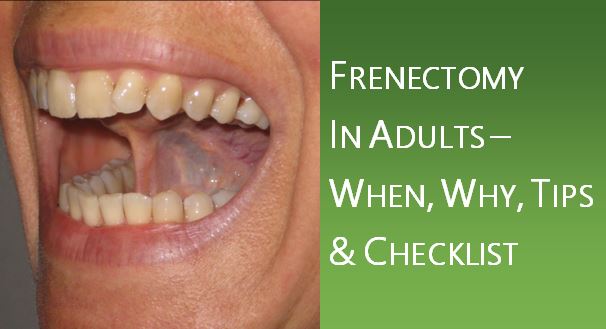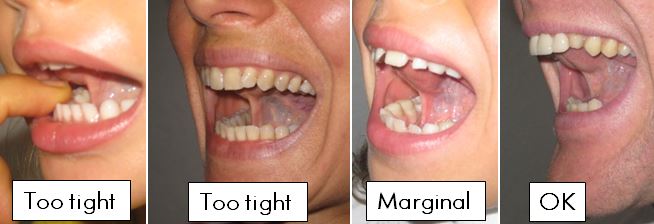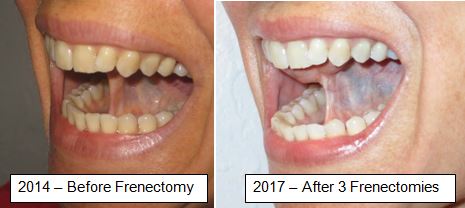
Why would an adult want to get a frenectomy? How should the frenectomy be done to maximize results? Learn from our family’s dental frenectomy experience – 3 adult lingual frenectomies, and 7 older-children lingual and labial frenectomies (children ages 5-8). This article summarizes our experience with both lingual and labial dental frenectomies. A summary Frenectomy Checklist is included in the Tips for Frenectomy section. Here is an outline of the content for those who like to skip around:
When to Get a Frenectomy
Potential Benefits of Frenectomy
When to Get a Frenectomy
There is not much information available about when it is appropriate for an adult to get a frenectomy. There is even less information available on frenectomy in children who are not babies.
There were several ‘clues’ that our family might benefit from frenectomies. Some of these only became obvious in hindsight after the procedures. Below was our list of clues, in order from strongest indicator to weakest indicator. Not everyone in our family had all of these indicators.
- Slurred Speech or Lisp – This is the most obvious indicator that frenectomy might be needed. Our youngest child’s speech slur disappeared after her first frenectomy at age 4.
- Tongue Resting Position on the Bottom Instead of the Top – The tongue should be on the roof of the mouth when resting and swallowing. I have empirically found that my body detoxifies better now that the tongue now rests on the roof of my mouth.
- Mouth Breather – Breathing through the mouth is a sign that the tongue is resting on the bottom of the mouth instead of the roof.
- Visually Looks Tight – Does it visually look tight? Here are some examples:


- Teeth Pointing Inwards – When the tongue is resting on the roof of the mouth, it naturally ‘thrusts’ against the front teeth when one swallows. The teeth develop with a slight outward flare. When the teeth instead point inwards, the tongue is likely not resting on the roof of the mouth.
- Osteopath Knowledgeable in Frenectomies says “Yes” – Sometimes osteopaths can feel the restriction in the body caused by a tight frenulum. One needs to find an osteopath who is familiar with frenectomies and the restrictions they can cause. Dr. Daniel Lopez, D.O. wrote a great article “How To Assess The Impact Of A Tongue Tie On Patients: Osteopathic Considerations”
- Slumped Posture / Hunchback – A tight frenulum can sometimes cause a slouched-over posture. Personally, my slouched posture straightened immediately after my first frenectomy. I felt like I could finally pull my shoulders back. Quoting from Dr. Daniel Lopez’s article: [1] “By producing so much tension in the front if the body, it pulls the body downs to a kyphotic posture and pull the shoulders forward.”
- Underdeveloped Face – The jaw or mandible may be underdeveloped because of a tight frenulum. Examples of proper development can be found in pictures mid-way down in the article: “Ancient Dietary Wisdom for Tomorrow’s Children.” These pictures demonstrate good space between the teeth, a wide palate, and full development of the jawbone.
- Below Average on Growth Chart – Adults on the growth chart? While adults aren’t growing anymore, their growth may have been restricted as a child by a tight frenulum. Our youngest child grew 2 inches and gained 3 lbs in the week after her first frenectomy.
- Difficulty Detoxing – What does ‘difficulty detoxing’ mean? Sometimes people are very sensitive to their food and environment. Other people can eat, breathe, and smoke whatever they want and feel great. If one is in the first category, a frenectomy might help with detoxification. How? Removing structural blockages, structural constrictions, and opening airways might help aid detoxification.
- Common / Chronic Upper Respiratory Infections – A tight frenulum can cause a constriction in the chest. This is often related to the previously-mentioned hunchback posture. The diaphragm and lungs can be affected, and sometimes chronic upper respiratory infections can result.
- MTHFR Mutations – Science is just learning about the connection between MTHFR mutations and frenectomies [2]. For our family, people with C677T mutations had the most need for frenectomy. Conversely, I would check methylation if a frenectomy is needed. The MTHFR treatment section has more details.
There is no magic number of the above clues that turn the answer from “No Frenectomy” to “Yes Frenectomy.” Deciding to have a frenectomy is a personal decision. The laser surgery itself isn’t bad, but the post-op is very painful (more details in Tips for Frenectomy). Still, I consider this a relatively low-risk procedure for potentially large benefits.
Potential Benefits of Frenectomy in Adults
What benefits can an adult see from frenectomy? Although adults are no longer growing, the frenulum can still cause tension that can create all kinds of symptoms. Below is a list of all the things I am aware of that can improve after frenectomy:
- Stand Up Straight / Better Posture / Reduced Hunchback
- Reduced Shoulder Tension / Back Pain
- Small Structural Shifts in Face
- Tongue Resting & Swallowing on the Roof of the Mouth
- Better Ability to Detoxify
- Breathing Through the Nose
- Fewer Upper Respiratory Infections
- Overall better mood and happier
The most amazing result for me was the improved posture. The results were immediate and noticeable by friends and family. Frenectomy was one of the best decisions I have ever made – for our whole family’s health.
Dr. Daniel Lopez shares his results in the article “Adult Frenectomy For Pain Relief: Osteopathic Considerations”
Here are pictures of my tongue before my frenectomies and after 3 laser frenectomies.

Notice a difference? Me Neither. In both pictures, I am sucking the tongue up to the roof of my mouth and then opening the mouth as wide as possible. Notice that in the post-frenectomy picture I can open my mouth slightly wider than in the pre-frenectomy picture. Other than that, I’d say the pictures don’t look all that different. The visible difference in the tongue may be small, but the difference in my structure and function is huge.
Tips for Frenectomy
My top frenectomy tips including finding a practitioner who uses a laser, doing pre-op exercises, and regularly doing post-op exercises. Our family’s tips for frenectomies are summarized in this Frenectomy Checklist. The sections below go into more detail than the checklist.
Find a Great Practitioner
I recommend finding a dentist who uses a laser to do the surgery. I have heard several negative outcomes from oral surgeons. Generally I think if too much is cut at once, the body has difficulty recovering, and osteopathically the midline can be lost. Nerve damage and broken blood vessels in the frenulum can be difficult for the body to heal.
The negative side of a dentist with a laser is that multiple ‘revisions’ might be necessary. Personally, I’d rather have several surgeries and a positive outcome than one surgery and risk a negative outcome. The time between revisions should be spent doing exercises to thin out the remaining frenulum for the next surgery. This means more can be cut, and the body will be better prepared to recover from the surgery.
If possible, an Oral Myofascial / Myofunctional Therapist (OMT) and osteopath should be added to the practitioner team. We had both on our team and found them beneficial.
OMTs can help with things like pre- and post-op oral exercises, reflex and release points, and oral/postural/breathing behavior modifications. In case an OMT isn’t available, I have created videos in the next two sections demonstrating our favorite exercises. Ideas from our OMT about getting the tongue up and breathing exercises can be found in the Orthodontics section.
An osteopath is harder to mimic with online information. A traditional osteopathic treatment involves manipulation of the body’s functional and structural systems. It’s kind of like a cross between a massage and a chiropractic treatment. The cranium is a 22-piece puzzle, and it’s best if those pieces are properly aligned before surgery. Note that osteopaths vary widely in their skill set, so check practitioner reviews carefully, and perhaps try a few different osteopaths.
Pre-Op
Exercises before surgery are essential to a successful outcome. Exercises should be done daily as part of a routine. They are designed to increase mobility, train muscles & thin out the tissue.
OMTs can customize exercises for each individual case. If an OMT is not available, I have created online videos. The pre-op exercises for labial are slightly different than the pre-op exercises for lingual frenectomy.
Dialing in lifestyle before frenectomy is important. This means eating well, sleeping well, and de-stressing. The body cannot work to heal after surgery and fight off infections if it is already exhausted. I also recommend requesting 2 days off work – the surgery day and the day after. Better yet, make it a Thursday and Friday and take the weekend off too!
An osteopathic or other cranial practitioner treatment can also be beneficial before frenectomy.
We tried several homeopathic and immune system supports after frenectomy. The most useful we have found is a homeopathic remedy called Body Mend. During pre-op is the time to order. If it is ordered after the procedure, it may arrive too late to really help.
Post-Op
Immediately after surgery, lightly swish with ozone water, hydrogen peroxide, salt water, or any other anti-microbial twice per day for the first week. I take my Fruit and Vegetable washer with me to the appointment and ozonate some swish water right in the office. I also recommend swishing after meals. Generally, we didn’t feel much like eating for the first 24 hours after frenectomy.
Immediately after surgery, it is essential to start the post-op exercises. It will be excruciatingly painful, but it is absolutely necessary! After a laser frenectomy, 30-60% of the skin will re-attach. These post-op exercises are what will make all the difference towards a 30% re-attachment instead of 60%.
The Labial Post-Op Exercises or Lingual Post-Op Exercises are slightly different. Continue the exercises every few hours for the first 2 days. After that, do the exercises twice a day for the next 3 months.
Vitamin C and Body Mend were helpful for us after surgery. We took oral liposomal Vitamin C of 10grams. Body Mend we did 5-10 drops orally every few hours for the first few days. We continued with it 2x per day for the next 10 days.
In my case, skin brushing after surgery was helpful in the face and neck area. It wasn’t nearly as beneficial for the two children.
Another osteopathic or cranial treatment can help make sure that the cranial bones are falling into the right place. Since the lingual frenectomy is on the midline, after the 2nd revision, I felt like my body had lost it’s midline. An osteopathic treatment after frenectomy is even more important than before.
Long term, exercises need to continue for the next 3 months. If a revision might be necessary, continue exercises straight through until the revision.
FAQ
Q: Can you recommend a practitioner for frenectomies?
A: I recommend Dr. Randy Miller DMD in Campbell, CA.
https://www.yelp.com/biz/randolph-e-miller-dmd-campbell
References
[1] Daniel Lopez DO “How To Assess The Impact of a Tongue Tie on Patients: Osteopathic Considerations,” July 24, 2014.
[2] Ben Lynch ND, “The Intersection of Tongue Tie & MTHFR,” 2014.
Was this information useful? If so, please consider donating to keep this site alive.
Last Updated:


How long should someone work with an OMT afterwards, or is a few sessions fine vs 15-20/year package? Can you just keep doing exercises after working with the OMT a few times or is it recommended to do many sessions. What do you think about neurocranial restructuring? It seems my symptoms slightly changed after even if i had some relief from headaches after first so it caused some anxiety. I was thinking I should focus on the tie removal before anything else for best results maybe.
I think it is possible to do just a few sessions with an OMT and then continue at home. These days, there are also many videos on Youtube that can give ideas for different exercises to keep from getting bored with the exercises.
I think neurocranial restructuring can be useful for some people. I have had it done several times myself, and I saw a bit of a difference but not much. For our family, Frenectomy was a much larger ‘bang for the buck.’ I would only recommend neurocranial restructuring in conjunction with osteopathic (or at the minimum chiropractic) treatments.
Hi,
I was wondering, I went to a practitioner because I have a lot of the symptoms for a tongue tie and I can’t touch the tip of my tongue to the roof of my mouth. Anyway, I fee like she didn’t really do a good job in diagnosing me and said I had to go to a mouth therapist first to do the exercises and then maybe she would do the procedure. I talked to the therapist on the phone and it seemed like she didn’t want me to have a tongue tie but just work on breathing patterns and etc that I already do correctly.. Is there any way that you can have a tongue tie produce without so much hassle? I just feel like the dentist doesn’t believe me even though I have the symptoms and under my tongue in my throat is always really tight. I would consider looking into more practitioners but there’s only one dentist (Seattle smiles) I found in Seattle that does tongue ties in adults. I would consider possibly traveling for the procedure if it was worth it
Thank you
Randy Miller in Campbell, CA does an excellent job. He only takes new patients by referral. You can tell him I sent you. Best wishes & good luck.
https://www.yelp.com/biz/randolph-e-miller-dmd-campbell